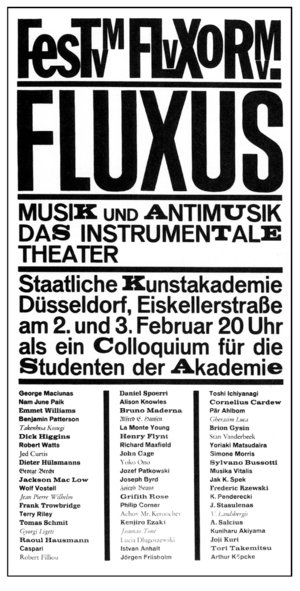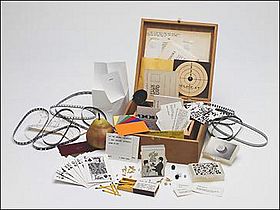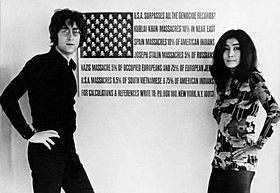George Maciunas facts for kids
Quick facts for kids
George Maciunas
|
|
|---|---|

George Maciunas on a 2016 stamp of Lithuania
|
|
| Born |
Jurgis Mačiūnas
November 8, 1931 Kaunas, Lithuania
|
| Died | May 9, 1978 (aged 46) Boston, Massachusetts, U.S.
|
| Nationality | Lithuanian/American |
| Education | Architecture and Graphic Design |
| Known for | Visual Art, Aesthetics, Artist's Multiples, Installation, Music, Sculpture, Performance, Mail Art |
| Movement | Fluxus |
| Spouse(s) | Billie Hutching |
George Maciunas (born Jurgis Mačiūnas; November 8, 1931 – May 9, 1978) was a Lithuanian American artist. He was born in Kaunas, Lithuania. George was a founder and the main organizer of Fluxus. This was an international group of artists, architects, composers, and designers. He is best known for putting together early art "happenings." He also created many influential art objects called "artists' multiples."
Contents
Biography
Early life and studies
George Maciunas' father, Alexander M. Maciunas, was an architect and engineer from Lithuania. His mother, Leokadija, was a dancer from Russia.
In 1944, his family left Lithuania to avoid the Red Army. They lived briefly in Germany. In 1948, Jurgis Mačiūnas and his family moved to the USA. They settled in Long Island, New York.
After arriving in the USA, George studied many subjects. He learned art, graphic design, and architecture at Cooper Union. He also studied architecture and music at the Carnegie Institute of Technology. Finally, he studied art history at New York University. His studies lasted eleven years, from 1949 to 1960. This started his lifelong interest in art history. He even began a huge chart to categorize all art styles.
What was Fluxus?
In the early 1960s, many avant-garde artists in New York were creating new kinds of art. They were influenced by John Cage's music classes. George Maciunas was one of these artists.
Fluxus became an exciting art movement. It playfully challenged old art traditions. Artists believed art should not be rare or just for selling. They wanted to mix art with everyday life. Maciunas loved diagrams and used them to map out art history and the story of Fluxus.
Fluxus shared ideas with other art movements like Pop Art. It challenged how art was valued and experienced. Fluxus artists worked together. They wanted to make art less about money and more about ideas. They created new art objects and performances. These included musical "concerts" and "olympic" games. George Maciunas believed that if people could experience the world like they experience art, art would not be needed. This means Fluxus wanted to show the art in everyday things.
First Fluxus events
In 1960, Maciunas met many future Fluxus artists. He met them in music classes in New York. In 1961, he opened the AG Gallery. He hoped to fund art shows by selling special foods. The gallery was short-lived but showed many new artists.
To avoid money problems, Maciunas took a job in Germany in late 1961. There, he organized the first Fluxus Festival in September 1962. This festival had many "concerts" and performances. These were actions done by Fluxus artists.
One famous event was Maciunas's version of Philip Corner's Piano Activities. The instructions asked people to "play" or "strike" the piano. Maciunas and others completely destroyed the piano. This event was so shocking it was shown on German television. The festival then traveled to other European cities. These concerts became very important to the history of Fluxus.
Return to New York and Fluxus products
Maciunas returned to New York in September 1963. He started working as a graphic artist. He also set up the official Fluxus Headquarters. He wanted to make Fluxus like a company. It would have "Fluxus Products" and a "Flux Mail-Order Catalogue."
However, his business ideas were not very successful. Maciunas spent a lot of his own money on Fluxus projects. He estimated spending about $50,000 over the years. This money was never earned back.
Flux boxes and other works
During this time, Maciunas created "Flux boxes" and "Flux-Kits." These were small boxes with cards and objects. Artists like Yoko Ono and George Brecht designed them. The first planned box was Fluxus 1. It was a wooden box filled with art from many artists.
Maciunas was a skilled graphic designer. He designed the packaging for Fluxus objects, posters, and newspapers. This gave the movement a unified look. He also designed special name cards for each artist. Maciunas felt that George Brecht's "Exit" artwork showed what Fluxus was about. It was just a card with the words "Word Event" and "Exit."
While Maciunas was alive, Fluxus works were often not signed or credited. This was to show that artists were "non-professional" and that "anything can be art and anyone can do it." Some works linked to him include:
- USA Surpasses all the Genocide Records!, around 1966. This was an American Flag comparing massacres in different countries.
- The Flux Smile Machine, around 1970. This machine used a spring to force a grimace. It was seen as a critique of capitalism.
- The film 12! Big Names!, 1973. People were promised to see 12 big names like Warhol and Yoko Ono. But the film only showed their names filling the screen, one after another, for five minutes each.
Professional life and Fluxhouse
Maciunas also had important jobs as an architect and graphic designer. He worked for well-known companies. As an architect, he created an innovative design for prefabricated buildings. These buildings could be put together quickly from ready-made parts. He even got a patent for his invention in 1961.
He called this design "Fluxhouse." It was meant to be a low-cost, efficient housing system. It could be used for single homes or larger communities. This design was eco-friendly and sustainable. It combined the benefits of standardized parts with the freedom to customize.
SoHo and the Fluxhouse Co-Operative
Maciunas is known as the "Father of SoHo" in New York. He helped develop old factory buildings into living and working spaces for artists. These were called the Fluxhouse Cooperatives. He imagined them as places where artists could live and work together.
With financial help, Maciunas started buying buildings in 1966. He converted them into artist lofts. This went against the zoning laws, which said SoHo was only for businesses. These laws were meant to allow a huge highway to be built. This highway would have destroyed much of the area. Maciunas and the artists helped stop the highway project.
Maciunas continued the co-op even though it was against the law. He bought buildings and sold units to artists. He ignored legal rules for selling property. This led to problems with the New York State Attorney General. Maciunas even started wearing disguises to avoid officials. An argument over unpaid bills led to him being badly hurt in 1975. He left New York soon after.
The Fluxhouse cooperatives are seen as very important for making SoHo a lively art area. SoHo has since become a place where new art movements have grown.
Later life and Fluxwedding
Maciunas was often sick. In 1977, he developed cancer. He died on May 9, 1978, in a hospital in Boston. Three months before he died, he married his friend, the poet Billie Hutching. After a legal wedding, they had a special "Fluxwedding" in a friend's loft. The bride and groom traded clothes. This event was filmed by video artist Dimitri Devyatkin.
Posthumous reputation
George Maciunas remains a mysterious figure. His reputation still causes strong reactions from artists and critics.
His life is the subject of a documentary film by Jeffrey Perkins. The film uses voices from Maciunas's friends. It includes interviews gathered since 2010.
Dedicated museums and collections
Maciunas's work has been shown in many major museums. Archives of his work are held in places like The Whitney Museum of American Art. The Museum of Modern Art has the largest collection of Maciunas and Fluxus works. It holds 10,000 items.
The Stendhal Gallery in Chelsea has held many exhibitions about George Maciunas. In 2005, they showed "To George With Love." This exhibition had original drawings, posters, and films. In 2006, they showed "George Maciunas, 1953–1978." In 2007, the gallery worked with Vilnius, Lithuania, to open the Jonas Mekas Visual Arts Center. This center's first show looked at important figures in avant-garde art, including Maciunas. In 2008, the gallery showed Maciunas's architectural projects, like his "Prefabricated Building Systems."
The George Maciunas/Fluxus Foundation started in 2011. It shows how Maciunas's ideas apply today. In September 2012, the foundation had an exhibition on his Fluxhouse housing system. "Fluxcity: Prefabricated/Modular Solution for Social Housing".
See also
 In Spanish: George Maciunas para niños
In Spanish: George Maciunas para niños
- Fluxus
- Anti-art
- An Anthology of Chance Operations
Films about George Maciunas
- George. Jeffrey Perkins, Documentary feature-length film/video portrait of George Maciunas, USA, 2018






